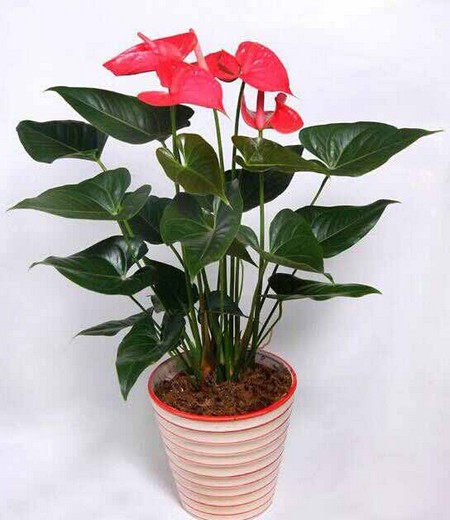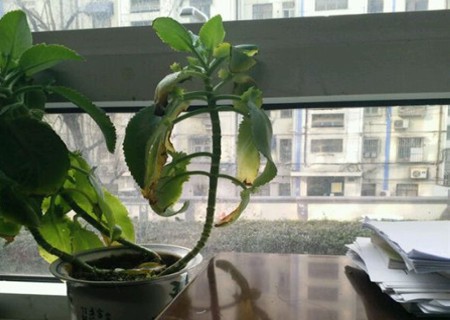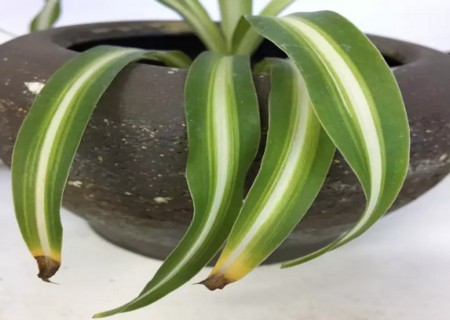How is the yellow and scorched edge of Anthurium andraeanum leaves going on?
Anthurium andraeanum, also known as Anthurium andraeanum, Anthurium andraeanum, is a perennial evergreen herb native to the tropical rain forests of South America. Friends who like to raise cut Anthurium andraeanum will more or less encounter Anthurium andraeanum leaves with yellow and scorched edges, rotten leaves and other situations, which will indeed make flower friends more sad, how to solve this kind of problem? The following is for you to analyze the specific reasons and prevention methods.

How is Anthurium andraeanum leaves yellow and scorched to return a responsibility?
1. The first situation is that the old leaves and new leaves turn yellow at the same time, the main reason is the lack of light for a long time. Solution: increase the light appropriately.
2. The second situation is that the old leaves turn yellow, which is mainly due to the long-term lack of water or the lack of thorough watering. Solution: water thoroughly every time.
3. The third situation is that if the new leaves turn yellow, but the old leaves are normal, it means that the amount of watering is too large, or the lack of fertilizer. Solution: control watering, or topdressing.
Specific preventive measures:
First of all, cut off the yellowing leaves, put them in the shade, wait for the water to dry, and then water it, don't fertilize it in a hurry. There may be two situations, one is that the air humidity is too low, that is, too dry, and the other is the lack of trace mineral elements.
In fact, it is to control the temperature and humidity, bask in the sun sooner or later, and apply fertilizer properly.
When Anthurium andraeanum leaves are yellowed, withered and rotten, it may also be caused by bacteria. To remove bacteria, you can spray 0.3% solution of garlic juice, 0.2% solution of vinegar or 8-1000 times of carbendazim and chlorothalonil.
Indoor maintenance of Anthurium andraeanum should be managed in a semi-overcast, humid and warm environment, with the best temperature between 20-25 ℃ and no higher than 33 ℃, otherwise it is prone to uncomfortable symptoms; the air humidity must be between 75-90%, and less than 50% of the leaves are prone to scorch edge drying.
When the Anthurium andraeanum leaves are yellow and scorched, first cut off the yellowed leaves and put them in the shade. Wait for the water to dry and then water it. Don't worry about fertilizing. There may be two situations, one is that the air humidity is too low, that is, too dry, and the other is the lack of trace mineral elements. Control the temperature and humidity, bask in the sun in the morning and evening, and apply fertilizer properly.
The symptoms of yellowing, drying up and decay of Anthurium andraeanum leaves are caused by bacteria. In order to remove bacteria, 0.3% solution of garlic juice, 0.2% solution of vinegar or fungicides such as carbendazim and chlorothalonil can be sprayed to prevent and cure. But this can not solve the fundamental problem, because Anthurium andraeanum has such symptoms, because the maintenance environment is not suitable, Anthurium andraeanum should be managed in a semi-shady, humid and warm environment, and the temperature should be between 20-25 ℃, not higher than 33 ℃, otherwise it is prone to uncomfortable symptoms; the air humidity must be between 75-90%, and the leaves are prone to scorch edge drying.
The leaves of Anthurium andraeanum are easy to turn yellow, so pay more attention to conservation. If you want to maintain it well, you have to know the causes and rescue methods of yellowing leaves. In this paper, we sort out some yellowing and rescue methods of Anthurium andraeanum leaves. I would like to share it with my friends who like breeding. I hope I can help you.
Cause analysis and treatment methods of yellowing of Anthurium andraeanum leaves:
1. Too much watering causes the leaves of Anthurium andraeanum to turn yellow (water yellow): the new leaves of Anthurium andraeanum turn yellow, and the old leaves are normal. Generally, too much water and too much water will make the medium in the basin too wet for a long time, or even stagnant water, causing some fibrous roots to rot, hindering normal breathing and absorbing nutrients, causing the leaves to turn yellow and fall off gradually.
Solution: we should pay attention to the weather conditions and the habits of Anthurium andraeanum to water.
2. The leaves of Anthurium andraeanum are yellowed (burning yellow) caused by soil discomfort: there are more salt and alkali in the medium and water in most areas of the north. Due to the lack of soluble iron that plants need to absorb in the medium, the leaves will gradually lose green and turn yellow.
Solution: use oxalic acid and other treatment media and water for watering flowers.
3. Air drying leads to the yellowing of Anthurium andraeanum leaves: when the indoor flower-growing air is too dry in winter, the leaf tip is often withered and yellowed, or the leaf edge is scorched, or the leaf is scorched and curled at the edge.
Solution: according to the growth characteristics of Anthurium andraeanum, increase the air humidity appropriately.
4. Lack of sunlight leads to yellowing of Anthurium andraeanum leaves (lack of light yellow): if Anthurium andraeanum leaves are placed in the shade or in places with insufficient light for a long time, it will lead to weak growth, thin and yellow leaves, no flowering or little flowering.
Solution: according to the growth characteristics of Anthurium andraeanum, increase the light intensity appropriately.
5. The leaves of Anthurium andraeanum turn yellow when the temperature is too low: if the indoor temperature is too low in winter, the leaves will turn yellow; if the room temperature is too high, the plant transpiration is too high, and the root water and nutrients are insufficient, which will also make the leaves yellow.
Solution: keep the temperature in the greenhouse relatively stable.
6. lack of fertilizer in Anthurium andraeanum leaves leads to yellowing of leaves (fat yellow): little fertilization, or no change of soil for a long time, lack of nitrogen and other nutrients in the soil lead to thin branches and leaves, thin and yellow leaves. In addition, excessive fertilization will also appear new leaves hypertrophy, uneven, while old leaves dry tip, scorched yellow shedding.
Solution: should immediately stop fertilization, increase watering, and remove part of the old soil, replace the new cultivated soil, carry out normal management.
7. Diseases and insect pests lead to yellowing of Anthurium andraeanum leaves, such as yellow spot and leaf blight.
Solution: the whole plant can be sprayed with 800 times of carbendazim wettable powder; red spiders and shell insects are among the pests, which can be prevented by special agents, or wiped with a dishcloth and rinsed with clean water.
Time: 2019-05-30 Click:
- Prev

The reason why the leaves turn yellow when they fall to the ground and what to do when the leaves are yellow
In the previous article, the editor talked about not only the medicinal value of this plant, but also its ornamental value. Not only can be dietotherapy, but also can be potted, is a very practical family potted plant. Many people in the basin spare no effort to cultivate this kind of plant that falls to the ground and takes root.
- Next

What about the yellow tip of the orchid leaves?
Magnolia is a perennial herbaceous green plant, often seen in the pastoral small fresh style of home environment, usually as a drape pot for viewing, very beautiful. But recently, a flower friend asked: my family has a pot of orchids, which grows well, but there is always the phenomenon of leaf tip yellowing and withering.
Related
- Fuxing push coffee new agricultural production and marketing class: lack of small-scale processing plants
- Jujube rice field leisure farm deep ploughing Yilan for five years to create a space for organic food and play
- Nongyu Farm-A trial of organic papaya for brave women with advanced technology
- Four points for attention in the prevention and control of diseases and insect pests of edible fungi
- How to add nutrient solution to Edible Fungi
- Is there any good way to control edible fungus mites?
- Open Inoculation Technology of Edible Fungi
- Is there any clever way to use fertilizer for edible fungus in winter?
- What agents are used to kill the pathogens of edible fungi in the mushroom shed?
- Rapid drying of Edible Fungi

